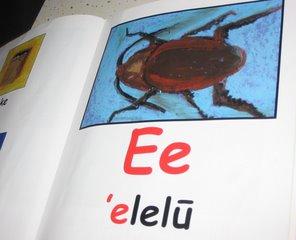Hawaiian alphabet: Difference between revisions
imported>Drew R. Smith No edit summary |
imported>Gareth Leng mNo edit summary |
||
| Line 18: | Line 18: | ||
As an oral tradition, handed down generation after generation, the true origins of the [[Hawaiian]] [[Hawaiian language|language]] are unknown. The Hawaiian alphabet, ''ka pī'''‘'''āpā Hawai'''‘''' i'', however, does not have such an obscure past. The Hawaiian alphabet was originally designed in the early 1800’s by American [[missionaries]] who wanted to print a [[Hawaiian bible]]. Due to the language being passed down as an oral tradition, the missionaries had to adapt the [[Roman alphabet]] to fit their needs. | As an oral tradition, handed down generation after generation, the true origins of the [[Hawaiian]] [[Hawaiian language|language]] are unknown. The '''Hawaiian alphabet''', ''ka pī'''‘'''āpā Hawai'''‘''' i'', however, does not have such an obscure past. The Hawaiian alphabet was originally designed in the early 1800’s by American [[missionaries]] who wanted to print a [[Hawaiian bible]]. Due to the language being passed down as an oral tradition, the missionaries had to adapt the [[Roman alphabet]] to fit their needs. | ||
[[Image:Hawaiian Alphabet.jpg|border|275px|The Hawaiian Alphabet, and Pronunciations]] | [[Image:Hawaiian Alphabet.jpg|border|275px|The Hawaiian Alphabet, and Pronunciations]] | ||
==Origins== | ==Origins== | ||
In [[1778]], British explorer [[James Cook]] made the first reported [[European]] discovery of [[Hawaii|Hawai`i]]. In his report, he wrote the name of the islands as "Owhyhee" or "Owhyee". By July 1823, they had begun using the phrase "Hawaiian Language." The actual writing system was developed by American [[Protestant]] missionaries on January 7, 1822. The original alphabet included <br /> | In [[1778]], British explorer [[James Cook]] made the first reported [[European]] discovery of [[Hawaii|Hawai`i]]. In his report, he wrote the name of the islands as "Owhyhee" or "Owhyee". By July 1823, they had begun using the phrase "Hawaiian Language." The actual writing system was developed by American [[Protestant]] missionaries on January 7, 1822. The original alphabet included <br /> | ||
Revision as of 02:18, 18 June 2009
| Hawaiian alphabet | |
|---|---|
| File:Hawaiian Alphabet.jpg | |
| Type | Alphabet |
| Spoken languages | Hawaiian language |
| Created by | American Protestant missionaries |
| Time period | 1822-Present |
| Parent systems | |
As an oral tradition, handed down generation after generation, the true origins of the Hawaiian language are unknown. The Hawaiian alphabet, ka pī‘āpā Hawai‘ i, however, does not have such an obscure past. The Hawaiian alphabet was originally designed in the early 1800’s by American missionaries who wanted to print a Hawaiian bible. Due to the language being passed down as an oral tradition, the missionaries had to adapt the Roman alphabet to fit their needs.
The Hawaiian Alphabet, and Pronunciations
Origins
In 1778, British explorer James Cook made the first reported European discovery of Hawai`i. In his report, he wrote the name of the islands as "Owhyhee" or "Owhyee". By July 1823, they had begun using the phrase "Hawaiian Language." The actual writing system was developed by American Protestant missionaries on January 7, 1822. The original alphabet included
A, B, D, E, F, G, H, I, K, L, M, N, O, P, R, S, T, U, V, W, Y, Z
and seven diphthongs
AE, AI, AO, AU, EI, EU, OU.
In 1826, the developers voted to eliminate some of the letters which represented functionally redundant interchangeable letters, enabling the Hawaiian alphabet to approach the ideal state of one-symbol-one-sound, and thereby optimizing the ease with which people could teach and learn the reading and writing of Hawaiian.
- Interchangeable B/P. B was dropped, P was kept.
- Interchangeable L/R. L was kept, R was dropped.
- Interchangeable K/T. K was kept, T was dropped.
- Interchangeable V/W. V was dropped, W was kept.
ʻOkina
Due to words with different meanings being spelled alike, use of the glottal stop became necessary. As early as 1823, the missionaries made limited use of the apostrophe to represent the glottal stop, but they did not make it a letter of the alphabet. In publishing the Hawaiian bible, they used ko‘ u ('my') from kou ('your'). It wasn’t until 1864 that the ʻokina became a recognized letter of the Hawaiian alphabet.
Kahakō
As early as 1821, one of the missionaries, Hiram Bingham, was using macrons in making handwritten transcriptions of Hawaiian vowels. The macron, or kahakō, was used to differentiate between short and long vowels. The macron itself never became an official letter. Instead, a second set of vowels with macrons were added to the language as separate letters.
Modern Hawaiian alphabet
The current official Hawaiian Alphabet consists of 18 letters. It contains eight consonants:
h, k, l, m, n, p, w, ‘
and ten vowels:
ā, a, ē, e, ī, i, ō, o, ū, u
To cite this article for a research paper or other publication, use this exact text: “Various authors, Hawaiian alphabet, Citizendium (http://en.citizendium.org/wiki/Hawaiian_alphabet), Retrieved 2024-12-26.”
